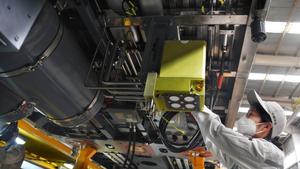 A technician works at a subsidiary of China Railway Rolling Stock Corp in Qingdao, Shandong province, over the weekend. (PHOTO / XINHUA)
A technician works at a subsidiary of China Railway Rolling Stock Corp in Qingdao, Shandong province, over the weekend. (PHOTO / XINHUA)
China Railway Rolling Stock Corp, the largest rolling stock manufacturer by production volume in the world, will expand its presence in nine areas, including wind power equipment, industrial robots and polymer composites, to enrich its core competence in the global arena, a top company executive said on Monday.
To mitigate the economic impact of the COVID-19 outbreak on the global market for industrial goods, CRRC will scout for new growth points from urban infrastructure projects, strategic emerging industries and modern service business this year, while continuing to make technology breakthroughs in developing the next-generation trains, said Liu Hualong, chairman of the centrally-administrated State-owned enterprise.
Based on the sound form and competitiveness of CRRC's wind power, new energy buses, polymer materials and other business units, we will add investment in key emerging industries during the 14th Five-Year Plan (2021-25) period
Liu Hualong, Chairman of the centrally-administrated State-owned enterprise
ALSO READ: CRRC cars meet global standards
The Beijing-headquartered group will deploy more resources in other fields such as new energy automobiles, environmental protection, photovoltaic power generation and marine engineering equipment, heavy construction and mining machineries, information and software solutions to transform into a conglomerate giant.
"Based on the sound form and competitiveness of CRRC's wind power, new energy buses, polymer materials and other business units, we will add investment in key emerging industries during the 14th Five-Year Plan (2021-25) period," he said, adding the company will further promote business restructuring and integration within its subsidiaries.
Liu said these moves will help CRRC better confront the challenges from foreign rivals, as a number of major mergers and acquisitions have occurred in the global rail transit equipment industry, and the market concentration rate has significantly risen since 2015.
Eager to counter China's expansion after China's CSR Corp and CNR Corp merged and formed CRRC in 2015, French train maker Alstom SA acquired train-signaling business from the United States-based General Electric Co in the same year, while Japan's Hitachi Ltd acquired Italian rail equipment maker AnsaldoBreda S.p. A and signal system provider Ansaldo STS S.p. A to seal more deals in developed markets.
Alstom SA also announced that it would pay up to 6.2 billion euros (US$6.91 billion) to purchase the rail division of Canada's Bombardier Inc last month. Though it has not received the green light yet, the French firm has been keen to merge with Siemens' mobility unit to further dominate Europe's rail market, a clear sign of pushing the Chinese player out and notably cut options in this massive market.
Liu said it is normal for major players to conduct M&A in the rail transit equipment sector. The Chinese company will continue to introduce new strategic investors and digital technologies into its products, as well as compete with foreign competitors in the global market with advanced and durable products, especially in economies related to the Belt and Road Initiative.
CRRC signed contracts to provide 18 new light-rail trains and five years of maintenance services under a contract valuated at 49.6 million euros for Porto Metro in Portugal in late January. After beating bids from Siemens Mobility and Skoda Transportation, the Chinese company landed its first deal to enter the urban rail transport market within the European Union.
The company entered the Philippines market for the first time in December last year by bagging an export order for three diesel-electric multiple unit trains with a design speed of 120 km/h. These will be delivered to the Philippine National Railways by July next year.
READ MORE: CRRC to step up efforts in overseas markets
Zhou Lisha, a researcher at the research institute of the State-owned Assets Supervision and Administration Commission of the State Council, said strong financing and a flexible investment strategy will help the Chinese train maker stay ahead of its foreign rivals, and high-speed train technology and a sophisticated global sales and management network will be the key growth drivers.
The group currently has 78 subsidiaries and 17 research facilities throughout the world. With 34 billion yuan (US$4.8 billion) in overseas assets and 6,000 foreign employees, its products and services are now available in 105 countries and regions.
CRRC's net profit was 8.41 billion yuan during the first three quarters of 2019, up 11.76 percent on a yearly basis, according to its latest financial report.


